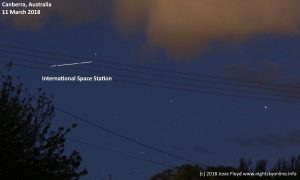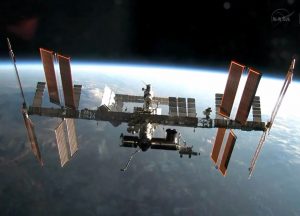(Posted 26 January 2019) Late January and early February 2019 presents a wonderful opportunity to see the International Space Station pass silently overhead in the morning predawn sky.
While the International Space Station does regularly pass over Australia, these passes usually occur during the day or in the middle of the night. This means that the station is not visible.

For the International Space Station to be visible for an Earth bound observer, it has to be a pass that occurs during the morning or evening twilight period. That way, the station is lit up by sunlight, but the observer on the ground is in darkness or semi-darkness.
| Location | Dates visible |
| Brisbane | 27 – 31 January 2019 |
| Cairns | 27 – 28 January 2019 |
| Canberra | 28 January – 4 February 2019 |
| Gold Coast | 27 – 31 January 2019 |
| Hobart | 28 January – 4 February 2019 |
| Melbourne | 28 January – 4 February 2019 |
| Sydney | 27 January – 4 February 2019 |
The above links take you to the highly recommended Heavens-Above website which generates customised viewing information for different locations. This includes a sky chart which provides a visual guide of when and where to look. Keep in mind that the charts are designed to be held over your head. If your location is not listed above, go here for tips on how to customise the information for where you live. Depending on your location, the International Space Station will be visible in the morning and/or evening sky.
If you haven’t seen the station pass overhead before, you are in for a treat. On a good pass, the International Space Station rivals the planet Venus for brightness. If you are really lucky, you will see a dazzling flare of light if the sunlight happens to reflect off the station’s giant solar panels at the right angle.
.
